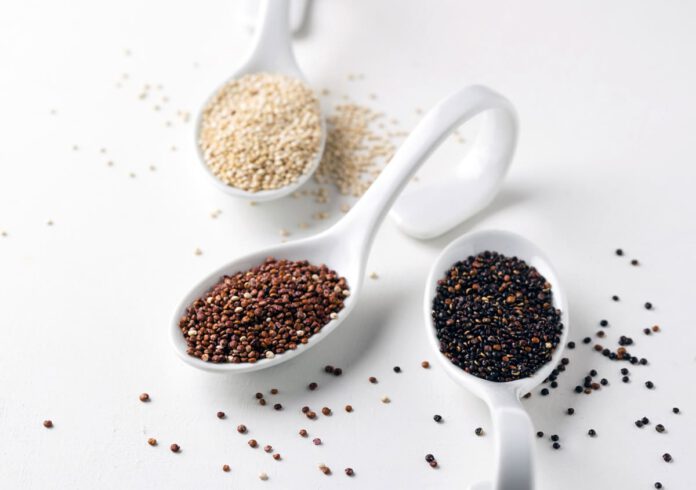Whether savoury or sweet, warm or cold, quinoa has conquered plates around the world over the last few years. Read on to discover the many talents this versatile grain possesses and how the cereal managed to persuade a fonds manager to found a Fairtrade company.
“Quinoa could help to solve world hunger.” James Livingstone-Wallace is convinced of this. The founder of the Fairtrade company Quinola provides European markets with the grain of the Incas since 2012. He is still as fascinated by the product today as he was ten years ago when he tasted it for the first time on a trip through South America. The Irishman worked for twenty years in the financial sector then, during the financial crisis, he lost his job. For him, however, it was not a reason to despair; instead, he looked for ways to expand his horizon. “I was fed up with making rich people even richer,” the former fonds manager says. The idea for a Fairtrade company developed: “I really wanted to do something sensible. Give disadvantaged people safe, economic prospects through their own work.”

An answer to climate change?
The United Nations called 2013 the international year of Quinoa, which benefited Livingstone-Wallace, and moved the until then underestimated grain from the Andes into the awareness of the world. “Throughout their long history, the UN have only chosen a plant three times; besides Quinoa it was rice and the potato,” the Fairtrade businessman says. But how come the grains the size of mustard seeds conquered even the political stage? The quinoa plant is incredibly versatile: it grows at temperatures between -8 and 38 degrees and at sea level hights of over 4,000 metres. The plant doesn’t need to be watered and hardly fertilized. And it provides vital nutrients. “The grain of the Incas could be the answer to climate crisis-induced food shortages,” Livingstone-Wallace summarizes. The CO2 balance also looks good. “The production of quinoa produces only one sixth of the greenhouse gases of rice, for example.”
Hidden treasure
In the Andes, quinoa has been grown for over 6,000 years. No grain grew on the desolate mountains. No surprise then that the original inhabitants saw the plant as a wonder plant that helped them survive. All that changed with the Spanish conquerors. They dismissed the so-called Inca wheat as cheap, poor people food and even went so far as to prohibit the cultivation. No wonder that the plant was hardly known in the West until a few years ago.
The quinoa boom of the last few years has, above all, one cause: the sensational components of the “mother of all grains,” as the Incas call it. The superfood contains large amounts of iron, folic acid, magnesium, zinc and manganese. In addition, quinoa is full of vitamins and complex carbohydrates. The latter must be first split by the body and is then used slowly and continuously. The feeling of satiety lasts for a long time — in contrast to the effect of simple carbohydrates such as can be found in products made with white flour or sweets. They cause the notorious ravenous hunger pangs.
If you struggle with your digestion, it would be a good idea to frequently add the grain from the Andes to your meal plan. The numerous dietary fibres serve as a food source for the healthy enterobacteria. Good news for vegetarians / vegans and all who want to reduce their meat consumption: quinoa can easily compete with animal-derived protein. Besides soy, it is the only plant that can provide the body with essential amino acids.

Pseudo wheat without gluten.
From their appearance the millet-sized grains remind of cereal. But quinoa belongs to the chenopods that also include mangold, spinach and beetroot. That means that they don’t contain any gluten, in contrast to the classic cereals. Quinoa comes in different colours. The white variety is the one seen most often in shops. It has a mild-nutty flavour and can be used in savoury as well as sweet dishes. Red quinoa keeps a good consistency during cooking and is therefore an optimal base for salads or bowls. Black quinoa has a slight earthy flavour and is thus good for hearty dishes. Both the black and red varieties have a longer cooking time than the white.
Washing is a must!
Quinoa seeds should only be cooked once peeled. The peel contains bittern, so called saponin, that naturally protects the plant from predators. The grains are usually only sold peeled in this country, but one should nevertheless wash them thoroughly — until the water runs clear and no more bubbles appear. The preparation is simple: simply mix one part quinoa with at least two parts salted water or stock and leave to cook for 15 minutes. Drain and it’s done! Quinoa is a classic side to meat, fish and vegetables or curries. For all recipes, rice can easily be substituted with quinoa. Quinoa plays the main fiddle in salads and is a nutritious filler in soups. If you have a sweet tooth, dishes such as quinoa and coconut pudding with mango or quinoa casserole with cherries will delight you.
These days, the Inca grain has even conquered the breakfast table. Quinoa flakes or puffed quinoa are a popular ingredient in müsli, porridge or yoghurts. The grain is so versatile that everybody will be won over — guaranteed!
